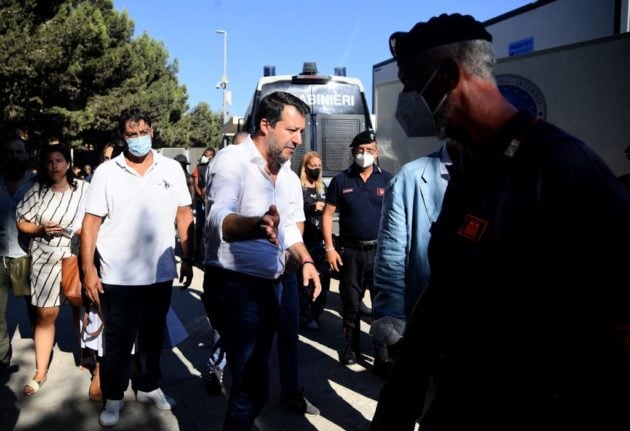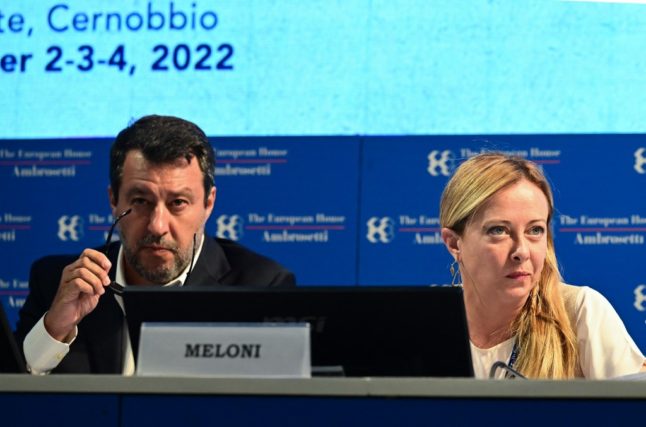If you’ve been following our coverage of the Italian elections in the last few days you’ll know that the right-wing alliance led by the far-right Brothers of Italy party under Giorgia Meloni has triumphed and looks set to form a new government in the coming weeks- or months.
TIMELINE: What happens next after Italy’s historic elections
This coalition of parties led by the post-fascist Brothers of Italy (Fratelli d’Italia, or FdI), along with the hard-right populist League, led by Matteo Salvini, and Silvio Berlusconi’s conservative Forza Italia gained around 45 percent of the vote.
EXPLAINED: Is Brothers of Italy a ‘far right’ party?
As the leader of the party that took the biggest share of the vote – around 26 percent – FdI leader Giorgia Meloni is on course to become the next prime minister of Italy.
While they’re often described as a ‘centre-right’ coalition in Italian media, at least two of these parties have policies which lean heavily towards the far right – particularly when it comes to immigration, which they frame as a question of national security.
League leader Matteo Salvini, well known for his populist, anti-immigration stance, is reportedly aiming to return to his previous post of interior minister if the right-wing bloc takes power, meaning his party would have the biggest influence over policies affecting foreign nationals living in Italy.
READ ALSO: ‘I plan to leave’: Foreigners in Italy fear for their futures if far right wins election
His party promotes a hard line against “illegal immigration”, with a heavy campaign focus on stopping migrant arrivals by sea from northern African countries. But the League also has a history of making life more difficult for documented immigrants and refugees.
Salvini was Italy’s interior minister between June 2018 and September 2019, during which time he passed a ‘security decree’ (often referred to as the ‘Salvini Decree’) that abolished the country’s humanitarian protection status for migrants and prevented asylum seekers from accessing reception centres.
The decree also made applying for Italian citizenship a more difficult and uncertain process, and made it easier for the state to remove Italian citizenship from those who have naturalised.
This decree was overhauled and softened in 2020 with the passage of a new law by the coalition government then in power.
The right-wing bloc has indicated it intends to bring the decree back, with the coalition’s immigration agenda in its joint election manifesto consisting of a series of mostly vague statements topped by a bullet point that simply reads “security decrees”.
READ ALSO: Five ways Italy’s 2022 elections will be different

On the topic of immigration, the manifesto also pledges that the parties will:
- “Fight irregular immigration and ensure orderly management of legal immigration;
- Promote the social and labour inclusion of legal immigrants;
- Defend national and European borders as requested by the EU with the new pact on migration and asylum, with border control and blocking of landings in agreement with the North African authorities, to prevent the trafficking of human beings;
- Create centres in non-European countries, managed by the European Union, to evaluate asylum applications.”
These pledges were summed up by FdI leader Giorgia Meloni in a debate with centre-left leader Enrico Letta.
Meloni said Europe should strike a deal with North African governments to keep their citizens at home and open local centres for refugee applications.
READ ALSO: Five key points from the Meloni vs Letta debate
“We must prevent the departure of the boats, open application centres and evaluate in Africa who has the right to be a refugee. By blocking illegal immigration, legal immigration can be reopened,” she said.
Italian newspaper Corriere della Sera noted that Meloni appeared “more cautious than usual on the issue of migration” in the pre-election televised debate.
Letta pointed out that the FdI leader no longer uses the term “naval blockade” – something she has repeatedly called for in posts on social media.

He noted that Meloni was also silent on her coalition partner Salvini’s preferred tactic of blocking rescue boats and refusing to allow them to land – something he is currently standing trial for in Italy, after repeatedly leaving people stranded at sea during his time in government.
Salvini potentially faces up to 15 years in prison on charges of kidnapping and abuse of office for using his position as interior minister to detain 147 people at sea in August 2019.
The trial is ongoing, with the next hearing set for December this year – however this doesn’t prevent Salvini from standing for election or taking office again.
While it seems likely that the League’s return to power would mean the return of such policies under new security decrees, there’s nothing in the manifesto or the debate so far which gives more concrete information on their plans, or on how the parties would treat legal migrants to Italy.
READ ALSO: Will Italy’s hard right win the election with a ‘super majority’?
And it’s also worth noting that how much power the new government will have to enact these policies will depend largely on the size of their majority.
Either way, given Salvini’s history of tightening rules on obtaining Italian citizenship and his ‘Italians first’ rhetoric, it’s safe to say foreign nationals in Italy shouldn’t expect life to get any easier under a new hard-right government – wherever they come from, and whatever their immigration status.
Economy and social matters
Of course it’s not all about immigration when it comes to the impact of the result on the lives of foreign residents – much will depend on the economy.
The programme agreed in advance by the coalition says Italy should make full use of the almost 200 billion euros ($193 billion) it has been earmarked under the EU’s post-pandemic recovery plan.
But it talks about changing the agreement with Brussels, which requires major structural reforms in return for the money. It says there are “changed conditions”, noting rising costs of energy and raw materials.
It calls for a reduction in the tax burden for families, businesses and the self-employed, including a flat tax for the latter, without giving any detail.
The citizens’ income, an unemployment benefit introduced under the populist Five Star Movement, will be abolished.
The programme also calls for a revaluation of the minimum pension, social and disability payments.
As inflation soars, there is also a promise to protect the purchasing power of families, workers and pensions, and reduce VAT on energy products.
Find all the latest news on Italy’s election here.



 Please whitelist us to continue reading.
Please whitelist us to continue reading.
There is no need to fear Salvini unless you come over illegally or from Africa as his policies are correct and will hopefully protect Italy once again.